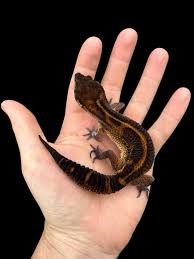GECKO MANDARIN BLACK NIGHT – DARK (Eublepharis macularius)
$400.00
Full Description
Here’s a detailed care guide for the Mandarin Black Night – Dark Leopard Gecko (Eublepharis macularius), a striking morph that combines the deep pigmentation of the Black Night line with the vivid tangerine-orange of the Mandarin line. The “Dark” designation refers to individuals with prominent dark coloration (near-black or deep charcoal) and muted but visible orange patterning.
Mandarin Black Night – Dark Leopard Gecko Care Guide
Morph Overview
| Trait | Description |
|---|---|
| Morph Name | Mandarin Black Night – Dark |
| Scientific Name | Eublepharis macularius |
| Morph Type | Line-bred (Black Night × Mandarin) |
| Appearance | Nearly black or dark gray body with traces of deep orange or tangerine; often includes Eclipse traits (solid/partial black eyes) |
| Experience Level | Intermediate to Advanced |
Size & Lifespan
| Trait | Value |
|---|---|
| Adult Length | 8–10 inches (20–25 cm) |
| Adult Weight | 50–90 grams |
| Lifespan | 15–20 years (in captivity) |
Enclosure Setup
Enclosure Size
-
Juvenile: 10–20 gallons
-
Adult: 20–40 gallon breeder (36″ x 18″ floor space ideal)
Substrate Options
| ✅ Safe | ❌ Unsafe |
|---|---|
| Slate or ceramic tile | Loose sand / calcium sand |
| Paper towels | Wood chips, bark, gravel |
| Reptile carpet | Small-particulate substrates |
| Bioactive (advanced) |
Hides & Furnishings
-
Warm Hide (placed over heating element)
-
Cool Hide (for thermoregulation)
-
Humid Hide (filled with moist sphagnum moss or eco-earth for shedding)
-
Include: climbing features, low décor, foliage, and rocks
️ Temperature & Humidity
| Zone | Fahrenheit | Celsius |
|---|---|---|
| Warm side | 88–92°F | 31–33°C |
| Cool side | 75–80°F | 24–27°C |
| Nighttime | 68–72°F | 20–22°C |
| Humidity | 30–40% ambient, 70–80% in humid hide |
Heating Tips
-
Use a UTH (under-tank heater) on a digital thermostat
-
Monitor belly heat with a digital thermometer probe
-
Avoid overhead basking bulbs unless needed to maintain ambient temps
Lighting Considerations
-
UVB is optional but beneficial (5% UVB linear strip like Arcadia ShadeDweller)
-
Due to potential Eclipse traits and Black Night lineage, these geckos are often light-sensitive
-
Avoid bright white overhead lights
-
Use dim ambient lighting and ensure multiple shaded hides
Feeding & Supplements
Diet
| Type | Common Feeders |
|---|---|
| Staples | Dubia roaches, crickets, BSFL, mealworms |
| Occasional | Superworms, silkworms, hornworms |
| Treats | Waxworms (rare, high-fat) |
Feeding Schedule
| Age | Frequency |
|---|---|
| Juveniles | Daily |
| Adults | Every 2–3 days |
Supplementation
| Supplement | Frequency |
|---|---|
| Calcium (no D3) | Always available |
| Calcium + D3 | 1–2× weekly |
| Multivitamin | 1× weekly |
Always gut-load feeder insects 24 hours before offering.
Maintenance
-
Daily: Spot-clean feces, replace water
-
Weekly: Wipe surfaces, clean hides
-
Monthly: Replace substrate (unless bioactive); deep clean enclosure
⚠️ Morph-Specific Considerations
| Trait | Note |
|---|---|
| Dark pigmentation | These geckos absorb more heat — use caution with heating elements |
| Light sensitivity | Common with Eclipse-influenced eyes; provide shaded areas |
| Color stability | Bright orange tones may fade if exposed to high stress or intense lighting |
| Genetic considerations | Avoid breeding two Black Night line animals without outcrossing — potential for health concerns from inbreeding |
| Handling | Typically calm but shy; may be reclusive during daytime due to photophobia |
Handling Tips
-
Start slow: short, calm handling sessions after a 1–2 week acclimation
-
Handle during dusk or evening
-
Avoid sudden lights or noise
-
Support the entire body while handling
✅ Care Summary
| Category | Recommendation |
|---|---|
| Enclosure Size | 20–40 gal horizontal space |
| Substrate | Tile, paper towel, or bioactive |
| Heat Source | UTH + thermostat (88–92°F hotspot) |
| Lighting | Low UVB optional; avoid harsh lights |
| Humidity | 30–40% ambient; humid hide required |
| Diet | Insectivorous; gut-loaded feeders |
| Supplements | Calcium (daily), D3/multivitamins (weekly) |
| Enrichment | Hides, rocks, tunnels, safe décor |
| Handling | Gentle, infrequent, stress-aware |

